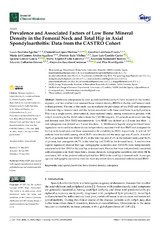Mostrar el registro sencillo del ítem
Prevalence and Associated Factors of Low Bone Mineral Density in the Femoral Neck and Total Hip in Axial Spondyloarthritis: Data from the CASTRO Cohort
| dc.contributor.author | Bautista-Aguilar, Laura | |
| dc.contributor.author | López Medina, Eloísa Clementina | |
| dc.contributor.author | Ladehesa-Pineda, Lourdes | |
| dc.contributor.author | Ábalos-Aguilera, María del Carmen | |
| dc.contributor.author | Ruiz-Vilchez, Desirée | |
| dc.contributor.author | Garrido Castro, Juan Luis | |
| dc.contributor.author | Gómez-García, Ignacio | |
| dc.contributor.author | Puche-Larrubia, María Ángeles | |
| dc.contributor.author | Salmoral-Chamizo, Asunción | |
| dc.contributor.author | Collantes Estévez, Eduardo | |
| dc.contributor.author | Escudero Contreras, Alejandro | |
| dc.contributor.author | Font-Ugalde, Pilar | |
| dc.date.accessioned | 2021-06-17T08:02:08Z | |
| dc.date.available | 2021-06-17T08:02:08Z | |
| dc.date.issued | 2021 | |
| dc.identifier.uri | http://hdl.handle.net/10396/21423 | |
| dc.description.abstract | Studies on osteoporosis in axial spondyloarthritis (axSpA) have focused on the lumbar segment, and few studies have assessed bone mineral density (BMD) in the hip and femoral neck in these patients. The aim of this study was to evaluate the prevalence of low BMD and osteopenia in the total hip or femoral neck and the factors associated with these conditions in axSpA patients. This was a single-centre, observational, cross-sectional study among consecutive patients with axSpA according to the ASAS criteria from the CASTRO registry. All patients underwent total hip and femoral neck DXA BMD measurements. Low BMD was defined as a Z-score less than −1, and osteopenia was defined as a T-score less than −1. Multivariate logistic and generalised linear regressions were used to evaluate factors independently associated with low BMD and osteopenia in the hip or femoral neck and those associated with variability in BMD, respectively. A total of 117 patients were included, among which 30.8% were female and the mean age was 45 years. A total of 36.0% of patients had low BMD (28.1% in the total hip and 27.4% in the femoral neck), and 56.0% of patients had osteopenia (44.7% in the total hip and 53.8% in the femoral neck). A multivariate logistic regression showed that age, radiographic sacroiliitis and ASAS-HI were independently associated with low BMD in the total hip or femoral neck. Factors that were independently associated with osteopenia were Body Mass Index, disease duration, radiographic sacroiliitis and ASAS-HI. In conclusion, 36% of the patients with axSpA had low BMD in the total hip or femoral neck. A younger age and radiographic sacroiliitis were the most important factors associated with decreased BMD. | es_ES |
| dc.format.mimetype | application/pdf | es_ES |
| dc.language.iso | eng | es_ES |
| dc.publisher | MDPI | es_ES |
| dc.rights | https://creativecommons.org/licenses/by/4.0/ | es_ES |
| dc.source | Journal of Clinical Medicine 10(12), 2664 (2021) | es_ES |
| dc.subject | Axial spondyloarthritis | es_ES |
| dc.subject | Bone mineral density | es_ES |
| dc.subject | Osteopenia | es_ES |
| dc.title | Prevalence and Associated Factors of Low Bone Mineral Density in the Femoral Neck and Total Hip in Axial Spondyloarthritis: Data from the CASTRO Cohort | es_ES |
| dc.type | info:eu-repo/semantics/article | es_ES |
| dc.relation.publisherversion | http://dx.doi.org/10.3390/jcm10122664 | es_ES |
| dc.rights.accessRights | info:eu-repo/semantics/openAccess | es_ES |

